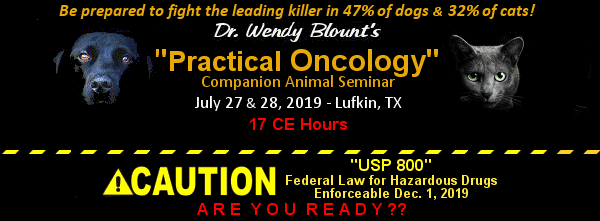USP 800 stands for Chapter 800 of the United States
Pharmacopeia which is about Hazardous Drugs and their Handling in Healthcare Settings. USP
General Chapter 800 provides standards for safe handling of hazardous drugs to minimize the risk
of exposure to healthcare personnel, patients and the environment.
USP 800 becomes enforceable on December 1, 2019. At the time of
this seminar that will be approximately only 4 months away, so the time is short to implement the new
guidelines designed for the proper handling of hazardous drugs in all veterinary clinics and other
medical settings.
USP 800 concerns much more that just chemotherapy drugs. There
are many other drugs kept on hand and used in most veterinary clinics
which would come under the new USP 800 guidelines.
Listed below are some of these other than antineoplastic drugs which pose considerable risk to
health care professionals:
- Apomorphine
- Azathioprine (Imuran®)
- Chloramphenicol (Chloromycetin®)
- Cyclosporine (Atopica®, Optimmune®)
- Dinoprostone (Lutalyse®)
- Estrogens
- Fluconazole (Diflucan®)
- Megestrol (Megace®)
- Melarsamine (Immiticide®)
- Methimazole
- Oclacitinib (Apoquel®)
- Oxytocin (Pitosin®)
- Progesterones
- Spironolactone (Aldactone®)
- Tacrolimus (Protopic®)
- Testosterones
The USP 800 guidelines require veterinarians to use various
methods of protection between people and hazards. These would include protective equipment,
biological safety cabinets, specialized gloves, gowns, syringes, adaptors, and closed-system
transfer devices (CSTDs).
The USP 800 goal is to keep all hazardous materials within the system
and prevent environmental contaminants from spreading.

